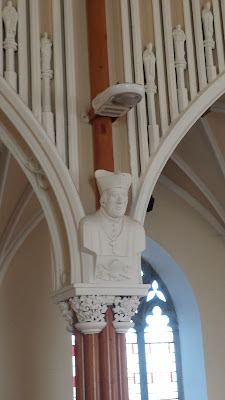December 22 is the feast of Saint Iotharnaisc of Clane, County Kildare, whom we met last year in a post on Saint Ultan Tua. It seems that Saint Iotharnaisc also had a Scottish link, where he appears under the Latinization of his name, Saint Ethernascus or as Saint Athernaise the Hermit or the Mute of Fife. It is interesting that he retains his reputation for maintaining the discipline of silence in both countries. Dom Michael Barrett has an entry for Saint Ethernascus in his calendar of the Scottish saints:
22 St. Ethernascus, Confessor.
FROM his retired life and spirit of recollection this Irish saint was known as "Ethernascus, who spoke not," or "The Silent." He was one of the chief patrons of Clane, in the county of Kildare. It is difficult to determine what was his precise connection with Scotland, but his office occurs with a proper prayer in the Breviary of Aberdeen. The church of Lathrisk, in Fifeshire, was dedicated to St. Ethernascus conjointly with St. John the Evangelist.
Dom Michael Barrett, O.S.B., A Calendar of Scottish Saints (Fort Augustus, 1919), 180.
Bishop Forbes supplies the collect for the day from the Breviary of Aberdeen:
ETHERNASCUS, C. December 22.—
The Breviary gives only a collect. "O God, who didst will that the soul of blessed Ethernascus, thy confessor, should penetrate to the stars of heaven, vouchsafe that, as we celebrate his venerable birthday, we may, by his intercessions, be deemed of thy mercy, in respect of his merits, meet to ascend to the joys of his blessed life, through our Lord." There is an antiphon to the Magnificat, but no lections to the feast.
In the Irish Kalendars, under this day, we find, in the Felire of Aengus—
Itharnaisc nad labrae.
[Itharnaisc who spoke not.]
In the Martyrology of Donegal, "Ultan Tua and Iotharnaisc, two saints who are (buried or principally venerated) at Claonadh, i.e. a church which is in Ui Faelain in Leinster." This is Clane, in the county of Kildare.
He is of Lathrisk in Fife, where we find a church dedicated to St. John the Evangelist and S. Ethernasc by David de Burnham on the v. of the Kalends of August 1243.—(Regist. Priorat. S. And. 348; 0. S. A vi p. 15.) The name Lanthrisk, or Lathrisk, contains evidently the Welsh Llan, which we find in Scotland elsewhere, as at Lumphanan, and Panmure and Panbride— the p and l being interchangeable, as we find in the Spanish where plenus becomes lleno. It is quite in accordance with probability that a Kildare saint should be found in the Church of Kenneth Macalpin. Thus we have a Cellach, at once abbot of Iona and Kildare, who died in 865.—(Grub, Eccl. Hist. i. 168.)
Alexander Penrose Forbes, D.C.L. Bishop of Brechin, Kalendars of Scottish Saints, (1872), 334.



%2Band%2BPetronella%2B(right)%2BO'Keeffe%2BInstitute%2BNewmarket%2Bwww.catholicheritage.blogspot.com.jpg)



























































































